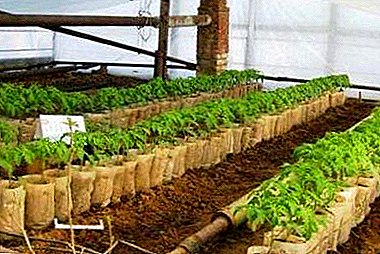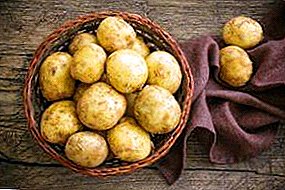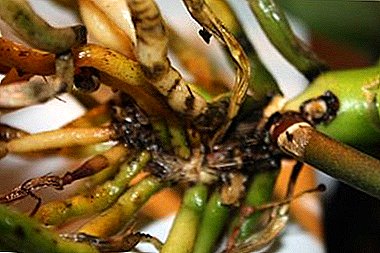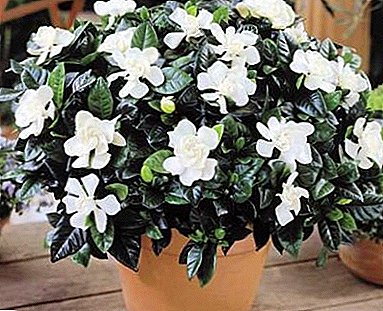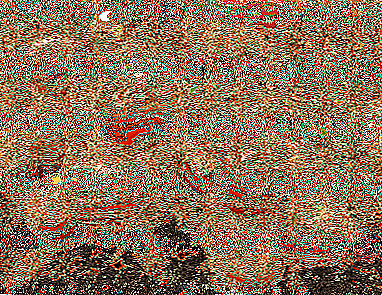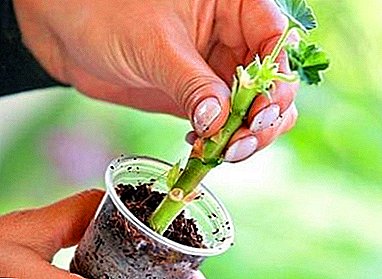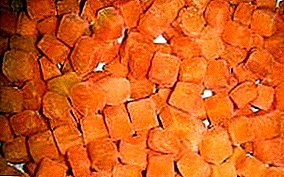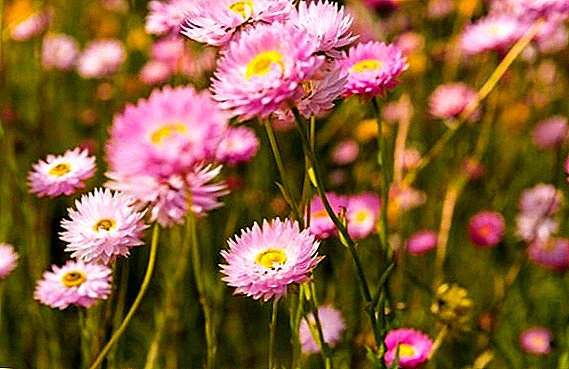 Helipterum is a bright annual flower, loved by many gardeners and florists, for the variety of color and simplicity in cultivation. Small inflorescences have a long flowering period and can decorate any corner of the garden or park. Today we talk about the use and cultivation of this plant.
Helipterum is a bright annual flower, loved by many gardeners and florists, for the variety of color and simplicity in cultivation. Small inflorescences have a long flowering period and can decorate any corner of the garden or park. Today we talk about the use and cultivation of this plant.
Botanical description
Helipetrum are mainly herbaceous varieties, but there are shrubs and semi-shrubs.
Herb plants include such as levkokorina, Pozharsky bell, cortaderia, Veronikastrum, larkspur field, gypsophila, paniculata, bluegrass, buteni, chicory.
The stalk may be bare or with a soft, white-haired edge, slightly branchy. The leaves are narrow lanceolate type opposite or rounded alternate, most often the foliage located rosettes at the bottom of the stem. 
The flowering period from the first months of summer to early autumn. Inflorescences - baskets, marginal petals-wrappers are long, with sharp edges, in large numbers surround a bright (from light yellow to bright golden color) tubular core.
The color of the marginal petals is represented by a large palette: white, pale pink, lilac, yellow, cherry, red.
Fading off a plant forms a fruit - achene with bristly tuft.
Distribution and habitat
Australia and the countries of South Africa are considered the birthplace of hellipterum; the subtropical and tropical climate will be the most favorable for the plant. About 2 centuries ago, the flower fell into the gardens of Europe, where it took root easily.
Important! Despite the southern origins, hellipterum is grown in Siberia and the Far East. True, the seeds in this climate do not have time to ripen, so they are purchased for planting in stores.

In temperate climates, the plant goes through a full stage of its development, adorns the garden all summer, in the southern regions sometimes blooms until October.
Popular types of Helipterum
View Mengles Helipterum grows from 35 cm to 50 cm, the stem without edge, thin but strong, the leaves are gray-green, heart-shaped, collected in the rosette. Inflorescences up to 3 cm in diameter, marginal petals of 2 types: white and pink. Flowering period from June to September, the seeds remain viable for up to 3 years.
There are two forms:
- atrosanguinea - with bright carmine wrappers;
- maculata - with dark spots on rose petals.
Varieties of this type does not have.
Helipterum pink is the most famous of the genus, having many varieties. 
It grows up to half a meter tall, the stems are lightly branched, the leaves are collected in a rosette, opposite, of elongated shape. Baskets of medium size up to 4 cm, tubular petals in the center of a bright yellow color, marginal arranged in 5-8 rows.
It blooms briefly, but magnificently, the seeds remain viable for up to 3 years.
It has 2 decorative forms - large-flowered and woody, the most popular varieties:
- "Red Boni" - red-pink petals with a brown middle;
- "Album" - white with a yellow center;
- new variety "Round dance" - almost the entire set of shades inherent in the mind with a black center;

- "Goliath" - inflorescences can have the color of coral, cherry, dark pink, inflorescence diameter up to 6 cm.

Heliprum Humboldt, known flower growers for the grade "Baby Sun". This plant is not high, up to 40 cm, with numerous shoots, small lanceolate forms of leaves and inflorescences, gathered in shields. The diameter of the shields is up to 6 cm, small inflorescences of bright golden-yellow color.
It blooms during the summer season, very beautiful in the cut, for a long time retains the brightness of the petals in winter bouquets.
Agrotechnics in the above plants has no differences, their varietal characteristics and application are also similar. Varieties are good for decorating the landscape, in fresh cut and dry bouquets.
Did you know? According to the ancient legend, dried flowers or immortals, as they are called florists and botanists, are a temporary container of the souls of early dead people.

Use in landscape design
The plant can be used in many compositions and design techniques. Bright flowers look great in monochrome plantings, with single use and in groups.
Harmoniously Helipterum will look:
- with spiny balls of allium;
- with bright hearts of inflorescences Dicentres;
- with a low primrose and its expressive foliage;
- with decorative foliage hosts;
- with undersized violet.
It is necessary to take into account that in the background of their own kind, bright colors with small petals, hellipterum can be lost.
The plant is good as a container culture, unusually look in the flower houses made of natural stone. It will decorate mixborders, rockeries and flower beds with summer flowers that have a long flowering.  Flowers can be planted as a curb along the garden path, surround them with a flower bed with shade-loving low-growing plants.
Flowers can be planted as a curb along the garden path, surround them with a flower bed with shade-loving low-growing plants.
Application in floristics
Contrary to popular belief about the use of plants as dried flowers, flowers are also used in living compositions. The stems are cut with half-distended buds in the afternoon.
Interesting contrasting compositions are obtained with large buds of poppies, peonies, with extravagant daylilies and slender irises. Florists have always been attracted to the combination of yellow and blue, for example, hellipterum with yellow wrappers and bells, cornflowers, or purple aconite.
Did you know? Homeland science floristics is Japan. Translated from the Japanese "ikebana" means the revival of flowers. This science owes its appearance to Buddhist monks.

The structure of the petals-wrappers in the plant resembles paper, perhaps, therefore, in winter bouquets, the flowers retain the brightness of the color. In dry compositions, plants are selected that will not be lost against each other, having differences in the shape of inflorescences and color.
Helipterum in dry bouquets goes well with such plants:
- statice with corymbose inflorescences of bright lilac color;
- xerrantum blue-blue shades;
- Kraspediya spherical yellow color;
- celesia cirrus with inflorescences with panicles of all colors of the rainbow;
- mordovnik (spiny bright blue ball);
- Physalis (bright orange fruit-lanterns).
In addition to live and dry bouquets, inflorescences are used in various handicrafts: panels, buttonholes, decorative paintings.
Important! For dry bouquets cut inflorescences no later than 2 days after flowering, dried in a dry, ventilated place, heads down.

Growing and caring for plants
Helipterum is one of the most unpretentious plants, the key to success is in the right place for planting.
Conditions of detention
Plants can be grown in containers and put them in the garden, or planted in open ground. To do this, you need to choose a place open to the sun most of the day, preferably not blown by drafts and not in a lowland where moisture can accumulate.
Plants must be constantly lit, even from each other they are planted at a distance, since sunlight is the main condition for lush flowering.
Soil and fertilizer
The ground for the pilot is needed loose and light with a neutral or slightly acid reaction. On alkaline calcareous or too acidic soils, the plant will simply wither. 
Important! It tolerates fertilizing poorly with organic matter, therefore it is better to fertilize with mineral compounds (not abundant and not often). It is enough to feed with nitrogen fertilizers at the beginning of growth and a complex for flowering plants during the formation of buds.
The main condition for good development and abundant flowering is loosening (saturation of the horses with oxygen) and weeding from weeds. If it is not possible to pay much attention to the weeding, you can cover the soil around the flowers with mulch from peat, straw, or compost.
Watering and moisture
Helipterum is drought tolerant, but still needs moisture. In the intense heat in the absence of precipitation watering should be carried out once a week. In this case, note that excessive moisture can cause rotting of the roots.
Breeding
Propagated by seed. When planting directly in open ground, seeds are sown in May. After the appearance of the first shoots, the planting is thinned, removing the weaker shoots, leaving about 20 cm between the shoots. 
Seedlings are sown in April in a common box for seedlings; seedlings will appear in two weeks. If there are two leaves, they are transplanted into peat pots, in which they are then transplanted to a permanent place in open ground (in the month of May).
Relation to temperature
In a temperate climate, he grows as an annual plant, as it does not tolerate cold winters.
To annual plants include such plants as venidium, haretail, bidens, lobariya, nigella damask, argirantemum, ageratum, nemofila.
In some particularly harsh regions with a short summer, its seeds do not have time to ripen. In regions in late spring, the plant is grown seedlings.
Possible difficulties in growing
Helipterum has a very delicate root system. Therefore, with a seedling method of cultivation, the seedlings dive into nutrient pots, and when caring for a plant, the soil is loosened very carefully, not deeply. For the same reason, gently dispense the amount of moisture for flowers, so as not to provoke root decay.
But it is necessary to take into account that with a long absence of moisture, the inflorescences will be much less than expected. 
Pests, diseases and prevention
The plant is not susceptible to pests and diseases.
As a preventive measure against possible diseases and pests to which the Astrov family is susceptible (it includes the helipterum), the following actions are taken:
- Seeds before sowing pickled in a solution of foundationol.
- The soil is disinfected with a solution of potassium permanganate.
- Landing is carried out in sunny places.
- Do not allow thickening.
- For insects used spraying infusions of marigolds, garlic.
- They clean the soil after cutting flowers, carefully dig it.
Dried flowers can be called unique plants: in the summer they delight with their bright abundant, often long flowering. In winter, a piece of summer is stored in dry compositions that do not lose their shades.
Feedback from network users
Treat the plant to dried flowers. Cut and dry it is necessary when the flower fully opens. Propagated by seeds, germination is good.




